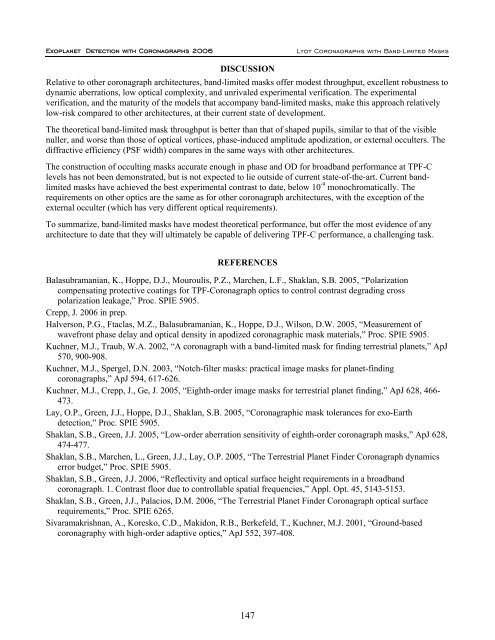Lyot Coronagraphs with Band-Limited Masks - Exoplanet ...
Lyot Coronagraphs with Band-Limited Masks - Exoplanet ...
Lyot Coronagraphs with Band-Limited Masks - Exoplanet ...
You also want an ePaper? Increase the reach of your titles
YUMPU automatically turns print PDFs into web optimized ePapers that Google loves.
<strong>Exoplanet</strong> Detection <strong>with</strong> <strong>Coronagraphs</strong> 2006<br />
<strong>Lyot</strong> <strong>Coronagraphs</strong> <strong>with</strong> <strong>Band</strong>-<strong>Limited</strong> <strong>Masks</strong><br />
DISCUSSION<br />
Relative to other coronagraph architectures, band-limited masks offer modest throughput, excellent robustness to<br />
dynamic aberrations, low optical complexity, and unrivaled experimental verification. The experimental<br />
verification, and the maturity of the models that accompany band-limited masks, make this approach relatively<br />
low-risk compared to other architectures, at their current state of development.<br />
The theoretical band-limited mask throughput is better than that of shaped pupils, similar to that of the visible<br />
nuller, and worse than those of optical vortices, phase-induced amplitude apodization, or external occulters. The<br />
diffractive efficiency (PSF width) compares in the same ways <strong>with</strong> other architectures.<br />
The construction of occulting masks accurate enough in phase and OD for broadband performance at TPF-C<br />
levels has not been demonstrated, but is not expected to lie outside of current state-of-the-art. Current bandlimited<br />
masks have achieved the best experimental contrast to date, below 10 -9 monochromatically. The<br />
requirements on other optics are the same as for other coronagraph architectures, <strong>with</strong> the exception of the<br />
external occulter (which has very different optical requirements).<br />
To summarize, band-limited masks have modest theoretical performance, but offer the most evidence of any<br />
architecture to date that they will ultimately be capable of delivering TPF-C performance, a challenging task.<br />
REFERENCES<br />
Balasubramanian, K., Hoppe, D.J., Mouroulis, P.Z., Marchen, L.F., Shaklan, S.B. 2005, “Polarization<br />
compensating protective coatings for TPF-Coronagraph optics to control contrast degrading cross<br />
polarization leakage,” Proc. SPIE 5905.<br />
Crepp, J. 2006 in prep.<br />
Halverson, P.G., Ftaclas, M.Z., Balasubramanian, K., Hoppe, D.J., Wilson, D.W. 2005, “Measurement of<br />
wavefront phase delay and optical density in apodized coronagraphic mask materials,” Proc. SPIE 5905.<br />
Kuchner, M.J., Traub, W.A. 2002, “A coronagraph <strong>with</strong> a band-limited mask for finding terrestrial planets,” ApJ<br />
570, 900-908.<br />
Kuchner, M.J., Spergel, D.N. 2003, “Notch-filter masks: practical image masks for planet-finding<br />
coronagraphs,” ApJ 594, 617-626.<br />
Kuchner, M.J., Crepp, J., Ge, J. 2005, “Eighth-order image masks for terrestrial planet finding,” ApJ 628, 466-<br />
473.<br />
Lay, O.P., Green, J.J., Hoppe, D.J., Shaklan, S.B. 2005, “Coronagraphic mask tolerances for exo-Earth<br />
detection,” Proc. SPIE 5905.<br />
Shaklan, S.B., Green, J.J. 2005, “Low-order aberration sensitivity of eighth-order coronagraph masks,” ApJ 628,<br />
474-477.<br />
Shaklan, S.B., Marchen, L., Green, J.J., Lay, O.P. 2005, “The Terrestrial Planet Finder Coronagraph dynamics<br />
error budget,” Proc. SPIE 5905.<br />
Shaklan, S.B., Green, J.J. 2006, “Reflectivity and optical surface height requirements in a broadband<br />
coronagraph. 1. Contrast floor due to controllable spatial frequencies,” Appl. Opt. 45, 5143-5153.<br />
Shaklan, S.B., Green, J.J., Palacios, D.M. 2006, “The Terrestrial Planet Finder Coronagraph optical surface<br />
requirements,” Proc. SPIE 6265.<br />
Sivaramakrishnan, A., Koresko, C.D., Makidon, R.B., Berkefeld, T., Kuchner, M.J. 2001, “Ground-based<br />
coronagraphy <strong>with</strong> high-order adaptive optics,” ApJ 552, 397-408.<br />
147
















